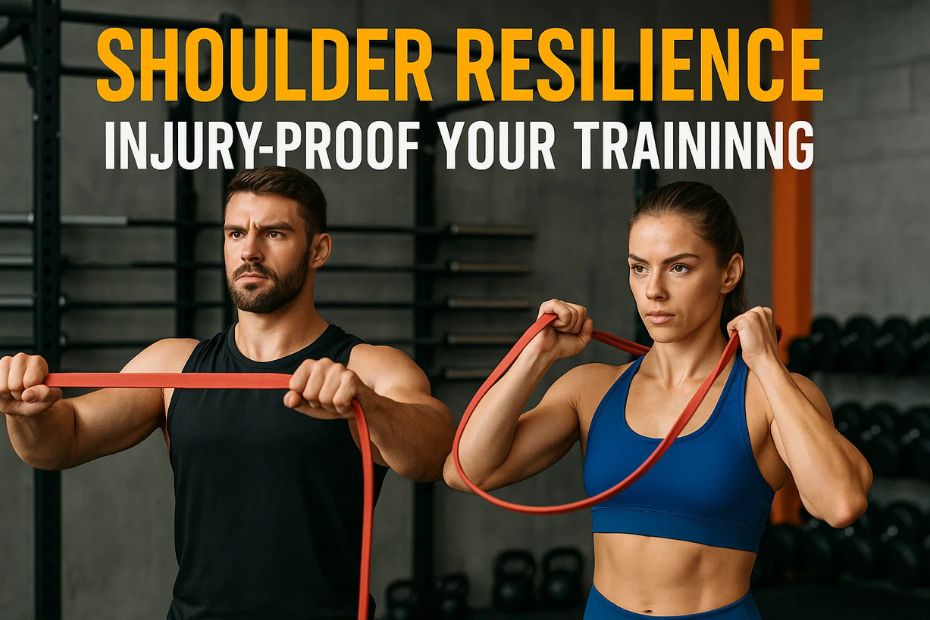For many gym-goers, the shoulders are both a source of pride and a common site of injury. A strong, stable shoulder not only supports pressing and pulling movements but also protects you from setbacks that can sideline your progress. If you’ve been training consistently and want to bulletproof your shoulders, it’s time to focus on resilience—strength, stability, and mobility working together.
Understanding the Rotator Cuff
The shoulder joint is the most mobile joint in the body, which also makes it inherently unstable. Stability comes largely from the rotator cuff, a group of four small but crucial muscles:
- Supraspinatus – initiates shoulder abduction (lifting the arm to the side).
- Infraspinatus – assists with external rotation.
- Teres Minor – helps with external rotation and stability.
- Subscapularis – responsible for internal rotation.
These muscles work together to keep the head of the humerus (upper arm bone) centered in the shoulder socket during movement. When neglected, they become vulnerable, leading to pain, impingement, or even tears.
5 Essential Prehab Exercises for Shoulder Health
Here are five key exercises that strengthen the rotator cuff, improve scapular stability, and prepare your shoulders for heavy lifting. Perform 2–3 sets of 12–20 controlled reps each.
1. Banded Pull-Aparts
- Hold a light resistance band at shoulder height with arms straight.
- Pull the band apart until your arms form a “T.”
- Focus on squeezing your shoulder blades together.
- Keep your chest lifted and avoid arching your lower back.
Why it works: Strengthens the rear delts and mid-traps, counteracting all the pressing most lifters do.
2. Face Pulls
- Attach a rope to a cable station at upper-chest height.
- Grab with an overhand grip and pull toward your forehead.
- Lead with your elbows, finishing with your hands outside your ears.
- Keep shoulders down and back throughout.
Why it works: Trains external rotation and scapular retraction, critical for healthy posture and pressing.
3. External Rotations with Band or Dumbbell
- Anchor a resistance band at elbow height.
- Stand sideways to the anchor, elbow bent at 90°, tucked to your side.
- Rotate your hand outward away from your torso.
- Return slowly under control.
Why it works: Directly strengthens the infraspinatus and teres minor—your rotator cuff’s external rotators.
4. Scaption (Scapular Plane Raises)
- Hold light dumbbells at your sides.
- Raise your arms at a 30° angle from your body (slightly forward).
- Stop at shoulder height, then lower slowly.
- Keep a soft bend in your elbows and thumbs pointing up.
Why it works: Trains the supraspinatus and improves upward rotation of the scapula without impingement.
5. Prone Y-T-W Holds
- Lie face down on a bench or stability ball.
- Form a Y with your arms overhead, hold for 2–3 seconds.
- Move arms out to a T, hold again.
- Bend elbows to form a W, squeeze shoulder blades down and back.
Why it works: Strengthens the entire scapular stabilizer complex (traps, rhomboids, rotator cuff).
A 15-Minute Shoulder Warm-Up for Upper Body Days
This routine primes your shoulders for pressing, pulling, and overhead work. Spend about 30–45 seconds per drill, moving smoothly and with control.
1. Foam Roll (2 minutes)
- Roll thoracic spine and lats to loosen tight tissue.
2. Banded Dislocates (2 minutes)
- With a light band, slowly bring arms overhead and behind the body, then back to the front.
- Focus on smooth range of motion, not forcing depth.
3. Scapular Wall Slides (2 minutes)
- Stand with back against a wall.
- Slide arms overhead while keeping low back and ribs against the wall.
- Emphasize shoulder blade movement.
4. Banded External Rotations (2 minutes)
- Perform with light resistance, keeping elbow tucked.
- Control both directions.
5. Face Pulls (3 minutes)
- 2–3 sets of 12–15 reps, focusing on form.
6. Push-Up Plus (2–3 minutes)
- In a push-up position, perform a small protraction of the shoulder blades at the top.
- Strengthens the serratus anterior, key for scapular stability.
Key Takeaways
- The rotator cuff is small but mighty—train it consistently.
- Prehab exercises like pull-aparts and face pulls build balance and resilience.
- A structured warm-up enhances performance and reduces injury risk.
By dedicating just 15 minutes before your upper body sessions, you’ll build stronger, healthier shoulders that support your strength goals for the long haul.
